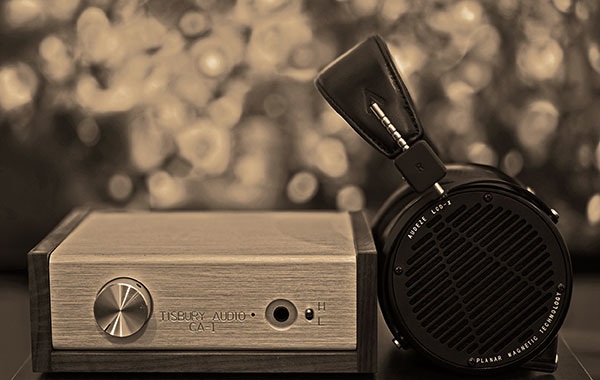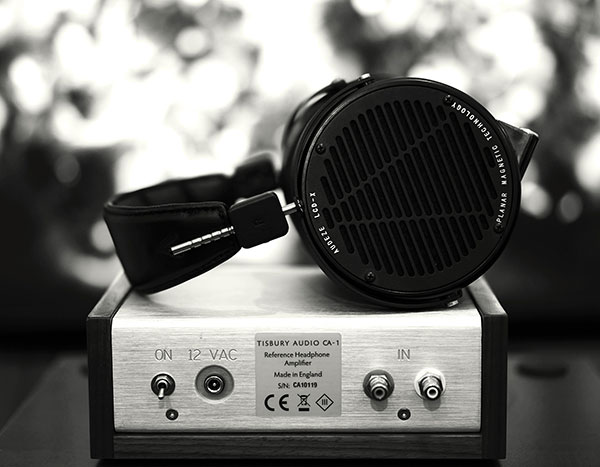This is not a vulgar looking brute of an amp. It is not designed with the intention to overawe with ton of knobs, switches and displays to catch your wondering eye. In fact it is beautifully crafted (by hand no less) and quite a bit smaller than I had originally thought before opening it up. Interestingly it is also quite a bit lighter than I presumed it would be. Most of the weight could arguably be contained within the beautiful American black walnut wood finish that encloses 75% of the amp chassis. Do not be fooled though, this is not a pieced of wood glued to a metal body type design. The wood itself is lined with copper shielding for enhanced isolation from everyday interferences form the outside world such as rf.
The Wood
This for me this is the stand out aspect of the CA-1 design, that wooden enclosure. Shades of Schiit design on the brushed aluminium chassis are obliterated by that wood enclosure, taking it to an entirely different place aesthetically. I remember those big old Pioneer and Matsui integrated tube amps awash with a mix of fine grain timber panels and spotless metal mix. Those classics still sell today in top condition for a tidy sum and one wonders if that same design will allow the CA-1 to outlast some of its more complex yet colder rivals. It literally could have been plucked from any of the last 4 decades and not look out of place in one’s collection. A timeless design gets full marks from me.
Front and Back
Simplicity on the front is matched by simplicity at the back of the CA-1. On the front the sturdy but high class Alps Blue Velvet volume pot sits on one end of the branded CA-1 decal and on the other extreme left is the quarter jack female port, a high/low gain switch and the LED power light which goes green to blue when music is running. On the back you have another simple switch for power, the 12AVC power socket and analog RCA left and right female jacks. Nothing else guys, that is it from Tisbury Audio. This is a pure headphone amp plain and simple. To get this working simply plug into the DAC or pre-amp of your choice, turn it on and throw in a set of headphones and you are good to go.
The grunt
Inside the CA-1 is anything but retro with real thought put into how everything functions in terms of isolation, impedance and power. The resulting output at 1w at 50ohms, whilst not as power hungry as say an EF6 or even the Oppo HA-1, does offer a high degree of flexibility with a large range of headphones. The gain switch levels combined with almost zero output impedance should turn the heads of sensitive IEM users for a start meaning this is not just a pure headphone amplifier but something that could be attractive to earphone users. At the same time throwing up the gain switch to high and it handily took care of more demanding headphones such as the K501/500 and took a decent stab at the Audeze range whilst falling short a bit once we got up to the Hifiman HE6 range. I am told by Wes that extensive referencing was done at the design stage with a Hifiman HE-500 without any issues so those with newer Hifiman cans shouldn’t fret. The HE6 is one heck of an inefficient power mad can and it is no shame on the CA-1 that it can’t quite deliver the goods.
The power supply
The CA-1 surprisingly light weight can also be attributed in a large part to the power supply setup being external rather than internal. I would normally expect to see something like that on smaller amps such as the Modi and Magni which have 16VAC outputs to external power sources more in line with portable amping solutions. A midsized desktop with a 12VAC external output is surprising but nonetheless welcome because of the odd issue I have had in the last few years with ground loops on some of my bigger amps with internal AC. Lower noise levels from the off board mains transformer will also help considerably with those wishing to use sensitive headphones and IEM’s.
Avoiding the pop
The CA-1 also sports another interesting and very useful feature, the muting relay system. Basically this is one heck of a safety feature and links quite closely with the LED blue/green system on the front panel which acts as the muting relay system visual indicator. In summary the muting relay system provides a critical buffer between the power supply and the performance of the amp when switching on and off and your precious headphones drivers. It prevents potential “pop” and blowing out of the drivers by shutting down the connection to the headphone jack immediately when power is interrupted or turned off. When turning it on you get a critical approx 2 second buffer of green before the power goes active (blue) on the amp. Coming from a country where blackouts are not only frequent but sometimes a planned norm for power shortages this is a very relevant feature indeed for me.
Click on next page for sound impressions…



